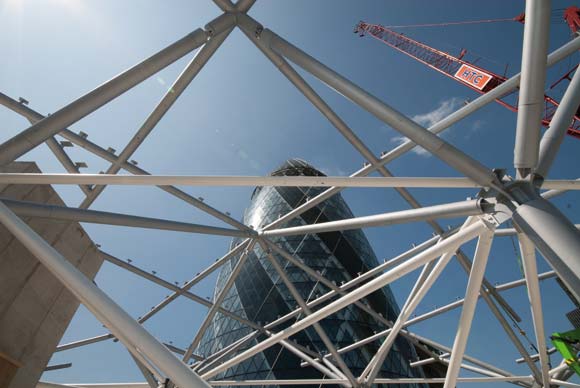SSDA Awards
Certificate of Merit – Weathering Steel House, Putney
A high-spec private home, spread over four floors, has been created by the redevelopment of a small building.
Using the rust-like appearance of weathering steel cladding, a cutting-edge private dwelling has been created in southwest London by redeveloping an existing small building.
The new house has two distinct parts. At the front is the main four-storey building, clad in weathering steel sheets interspersed with large glazed areas, while at the rear there is a separate single storey living space complete with glazed elevations and a green roof.
The two areas are joined at ground floor level by a transparent corridor complete with a glazed roof, walls and floor sections; below ground the areas are also linked by a concrete basement which runs to the edge of the single storey living space.
The concept for the superstructure of the house was for it to be a monocoque, whereby the façade system also acted as the primary structure to the building. The finished material therefore needed to be sufficiently stiff to act structurally, as well as provide a weather-tight enclosure and architectural interest.
“The selection of weathering steel as the external envelope developed out of early discussions with the client and as a direct response to his own position as an academic authority in historic metalwork, thus becoming a physical manifestation of his work and interests,” explains Eldridge London Architect Mike Gibson.
In addition to the architectural requirements, the constructional issues were significant. The footprint of the proposed house stretches between the boundary lines, leaving little working space for the contractor when onsite and required careful planning to construct a significantly challenging structure.
FACT FILE
Architect: Eldridge London
Structural Engineer: Elliott Wood
Steelwork Contractor: Suffolk Welding
Main Contractor: Famella“To achieve the architect’s proposed geometry and the desired millimetre accuracy in alignment of finishes, required a huge number of bespoke steel connections and steel to structural glass interfaces,” explains Elliott Wood Associate Penny Gowler.
Steelwork was adopted as the primary structural material, with weathering steel as the external finish. This met the architectural requirements set out, as well as allowing the use of cladding as a stressed skin in combination with ribs, minimising requirements for additional primary structure to the perimeter.
The use of a monocoque type structure was developed towards a series of prefabricated pods that could be erected onsite quickly and accurately.
“By utilising 3D modelling we were able to produce the steel elements quickly and accurately,” explains Suffolk Welding Director Ian Melton.
The steel connections were achieved by simply bolting the pods together onsite and then welding the weathering steel at its ‘seams’ to form a weatherproof envelope. To minimise heat loss, the connections between the panel and the internal floor structures were carefully detailed to prevent the junction creating a thermal bridge.
The prefabricated boxes were initially trial erected in the steelwork contractor’s workshop, which gave the opportunity to begin structural glass procurement far earlier in the programme than would usually be possible. This greatly improved speed of construction of the structural elements.
It illustrates what can be achieved by the closest attention to detail, and unified teamwork by architect, engineer and steelwork contractor/erector, as all details have been considered, coordinated and beautifully made, say the judges.














